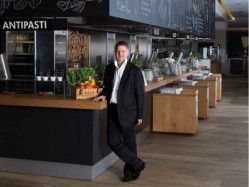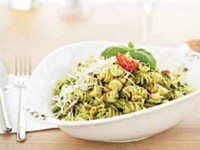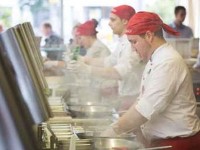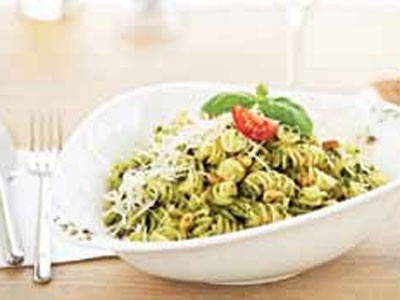Business Profile: Vapiano

Vapiano is an Italian restaurant chain run by Germans, and the long-running internal joke is that everybody should just be thankful it’s not the other way round. The chain is operated with the ruthless efficiency and levels of standardisation that are normally associated with the fast-food sector, but everything at this ‘fresh casual’ pizza-pasta restaurant is made on site from scratch each and every day.
Our tour of the branch in Southwark, London, ends with a rare glimpse of the Mangelberger. It’s essentially an ultra-high tech fuse cupboard, UK managing director Phil Sermon explains with no small measure of pride, which is controlled remotely from Vapiano’s HQ in Bonn. A daunting mass of winking lights, trip switches and ethernet cables, it automatically adjusts lighting levels according to the seasons and sends data back to head office on overall energy consumption in real time.
“I’ve worked for some great companies, but Vapiano is on another level in terms of organisation and structure. Every system is thought through and efficient, and there’s a place for absolutely everything,” says Sermon, who is a relative newcomer to the company having been appointed in the middle of last year. “It’s something of a cliché, but the Germans create things that do what they’re supposed to do, just look at the reputation their cars enjoy.”
World class operator
Founded in 2002 in Hamburg, Vapiano (it means ‘go slowly’, which is somewhat ironic for a fast-casual restaurant group) has grown to become a truly international player with 135 branches in countries as diverse as Norway, Brazil, Australia and South Korea and a plan to double its global reach by 2016. It operates 45 restaurants in Germany and the group also has a big presence in the US, Sweden, the Netherlands, Switzerland and Austria. Gregor Gerlach, one of the group’s original investors, is chairman and still retains a significant slice of the business, but the majority shareholder is now German venture capital outfit Mayfair.
When compared to its progress in the US and most other major countries in northern Europe, growth in the UK has been slow. A branch was opened on London’s Great Portland Street in 2008 followed by Southwark in 2011. “The performance in the UK market needed to be appraised. We’re now trading above the group average and the company views the UK as a key area for expansion, London in particular,” explains Sermon, whose CV includes a seven-year stint at pub giant JD Wetherspoon as head of food and latterly operations director roles at Bay Restaurants and Punch Taverns. The UK arm of Vapiano filed an operating loss of just under £300,000 in 2011, but turned things around in 2012 to report an operating profit of £372,509 last year off a turnover of £6.6m.
The international business is a mix of franchises, partnerships and company-owned sites, with the UK contingent falling into the latter category. Unlike most international chains, there is very little variation between Vapiano branches globally. In the Middle East pork and alcohol are avoided for religious reasons, but aside from that everything from the menu items and the layout of the chefs’ stations to the concept’s corporate canteen-meets-contemporary-Italian look is identical.
“It’s the intention that the Vapiano experience is the same whether you’re in New York, Seoul or Stockholm,” says Sermon. “That said, the company does keep things fresh by picking interesting buildings. We have a restaurant in Vienna that trades from a former Moulin Rouge, for example.”
Chips with everything
Like fellow counter-ordering groups Nando’s and Gourmet Burger Kitchen, Vapiano dispenses with full table service to offer a more flexible experience and turn tables quicker. But the group takes it a stage further with its RFID (radio frequency identification) chip cards, which – although now not unique to the business – remain Vapiano’s principal differentiator. All customers old enough to use them are issued with a card on entry, ‘tap-in’ transactions at each counter and surrender their card on the way out to settle up.
Each diner having a personal tab avoids the headaches that come with complex group bill calculations or getting dragged into paying for other people’s pricier items. “It’s somewhere we’ve all been before. It can be very frustrating when you’re out with a big group to pay for other people’s items when you’ve eaten very little yourself,” says Sermon. As the Southwark branch begins to fill up, the usefulness of such a system for some occasions becomes apparent. A group of work colleagues aren’t bound to arrive and leave at the same time and a table of students can treat the Southwark Street restaurant like an extension of their common room. “We can turn our tables up to six times a day – on a really good Saturday our 420-cover Great Portland Street site does 3,000 covers. Some guests are out in 20 minutes, but the set-up also allows people to spend bigger chunks of time here in a way they probably could not in conventional restaurants. For example, we’re popular with networking groups because people can pay for their own items and drop in throughout the session,” he says.
Because each customer is effectively treated as an individual, food comes as it is ready – an arrangement that is more likely to suit groups of younger diners than older couples, especially with pizzas taking up to five minutes longer to cook than the pasta dishes. This is backed up by the chain’s detailed demographics research, with 80 per cent of customers aged between 18 and 35.
Food and drink is ordered from various stations – including pizza, pasta, salad and bar – but the hit the group takes from not being able to upsell extra drinks, coffee and desserts at table is partly mitigated by roving staff armed with hand-held PoS systems on busier evenings. The chefs are servers as well as cooks, which, Sermon says, does present a recruitment challenge for the group.
“We need to make sure applicants can interact with people effectively, but the model does make for great theatre, people like watching their food being cooked to order.”
Aside from a few antipasti dishes – including carpaccio, vitello tonnato and bruschetta – the range of product categories is very tight, just pasta, pizza and salads. All the pasta is made on site using a £30,000 machine (German-made, of course), which can produce a wide range of shapes and styles, from spaghetti and pappardelle to fusilli and penne. Customers choose one of around 20 sauces, which range from classic to downright bonkers – duck breast, vegetables, curry sauce and peanuts, anyone? Sauces are made to order in a wok-shaped pan set over a custom-made induction hob. There are a similar number of options for pizza and customers are given a pager to alert them when it’s time to collect.
Made from scratch
While most kitchens have a compartmentalised approach to preparing food to better deal with dietary requirements, Vapiano takes it to an extreme with all dishes and preparations designed to be adjusted easily. Every savoury dish is made entirely from scratch in front of the customer allowing them to fine tune their meal in consultation with the chefs. “They’re trained to guide them towards something that’s going to taste good and we’d recommend trying our own recipes first, but, ultimately, it’s up to the customer – if they want beef in their pumpkin soup or chicken on their margherita they can have it,” says Sermon.
Pizza and pasta dishes are arranged into four price-points ranging from £6.75 to £9.75, undercutting Vapiano’s most obvious competition in the chain pizza-pasta space by around 20 per cent. It results in an average spend per head of £11.47 – a very similar ticket price to Nando’s and Gourmet Burger Kitchen.
Training is also broken down for speed and ease of delivery in a manner comparable to the fast-food sector, where staff tend to be responsible for a small range of specific tasks. There are nine different stations to learn (including back-of-house functions such as prep kitchen and wash-up) and all ‘Vapianisti’ are encouraged to master as many as possible as they progress through the company.
To qualify for any senior management role (including Sermon’s own) staff need to be able to run all nine stations.
“Before I started this job I went to Germany to train for a couple of months, so I know all the stations. That creates a great working relationship with staff because management know all the roles inside out. Staff are also tested regularly on tougher items and any customer complaint triggers an assessment as well,” says Sermon.
Expansion plans
Last year, Vapiano announced it had a £30m budget for UK expansion and was targeting 20 sites in London over the next couple of years. This appears to have now been revised because finding the very large properties the model requires has proved quite a task. “Clearly our parent company’s covenant strength is a great asset, but it’s still tricky to locate sites that are big enough, which is why I won’t put a number on UK expansion – it’s all site-dependent. If the right thing comes up we’ve got the cash ready to take it.”
Sermon is on the hunt for sites between 6,000 and 10,000sq ft and sees new developments in the vein of Westfield and Trinity Leeds (in West Yorkshire) as key opportunities for the group.
London is the focus, but Vapiano will also consider other major UK cities: Birmingham was mooted last year as a possible first location outside the capital. Early 2014 will see the opening of a Vapiano on London’s Wardour Street in a basement space once home to nightclub Lo Profile.
The fast-changing Soho thoroughfare is often seen as a testing ground for restaurant concepts, and it will be interesting to see how well Vapiano Soho fares against younger and perhaps more modish outfits. If Soho-ites fall for the chain’s blend of speedy service, well-integrated tech and everyday prices its prospects in the UK will be given a major boost.






























